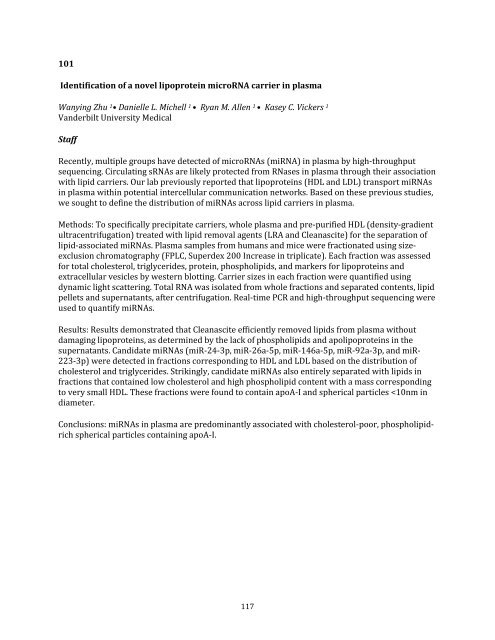2017 Cardiovascular Research Day Abstract Book
Create successful ePaper yourself
Turn your PDF publications into a flip-book with our unique Google optimized e-Paper software.
101<br />
Identification of a novel lipoprotein microRNA carrier in plasma<br />
Wanying Zhu 1 • Danielle L. Michell 1 • Ryan M. Allen 1 • Kasey C. Vickers 1<br />
Vanderbilt University Medical<br />
Staff<br />
Recently, multiple groups have detected of microRNAs (miRNA) in plasma by high-throughput<br />
sequencing. Circulating sRNAs are likely protected from RNases in plasma through their association<br />
with lipid carriers. Our lab previously reported that lipoproteins (HDL and LDL) transport miRNAs<br />
in plasma within potential intercellular communication networks. Based on these previous studies,<br />
we sought to define the distribution of miRNAs across lipid carriers in plasma.<br />
Methods: To specifically precipitate carriers, whole plasma and pre-purified HDL (density-gradient<br />
ultracentrifugation) treated with lipid removal agents (LRA and Cleanascite) for the separation of<br />
lipid-associated miRNAs. Plasma samples from humans and mice were fractionated using sizeexclusion<br />
chromatography (FPLC, Superdex 200 Increase in triplicate). Each fraction was assessed<br />
for total cholesterol, triglycerides, protein, phospholipids, and markers for lipoproteins and<br />
extracellular vesicles by western blotting. Carrier sizes in each fraction were quantified using<br />
dynamic light scattering. Total RNA was isolated from whole fractions and separated contents, lipid<br />
pellets and supernatants, after centrifugation. Real-time PCR and high-throughput sequencing were<br />
used to quantify miRNAs.<br />
Results: Results demonstrated that Cleanascite efficiently removed lipids from plasma without<br />
damaging lipoproteins, as determined by the lack of phospholipids and apolipoproteins in the<br />
supernatants. Candidate miRNAs (miR-24-3p, miR-26a-5p, miR-146a-5p, miR-92a-3p, and miR-<br />
223-3p) were detected in fractions corresponding to HDL and LDL based on the distribution of<br />
cholesterol and triglycerides. Strikingly, candidate miRNAs also entirely separated with lipids in<br />
fractions that contained low cholesterol and high phospholipid content with a mass corresponding<br />
to very small HDL. These fractions were found to contain apoA-I and spherical particles


